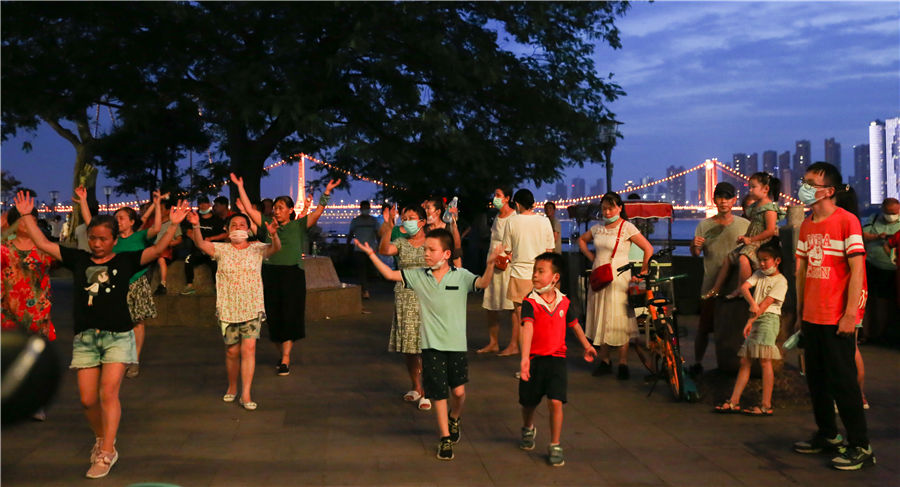
China's strict prevention and control measures meant the spread of the novel coronavirus in the country was largely brought under control in early April, which was marked by the lifting of the lockdown on Wuhan, capital of Hubei province. Nearly four months have passed since the lifting, the city ushered in the hoped-for economic recovery, as prevention and control measures are becoming a new normal.
Work resumption rate in the city's catering industry, which was among the hardest hit by the outbreak, was 78 percent on Aug 1, up from 13.3 percent on May 1, according to the city's dining industry association. Liu Guoliang, president of the association, said that over 80 percent of businesses are back to work in the industry, which is better than expected.
Under the Wuhan Yangtze River Bridge, a steady stream of people can be seen along the riverbank from evening to late night, enjoying the coolness, singing or dancing. Many newlyweds leave their footprints in front of the landmark Hankow Customs House, taking photos to mark the occasion of the revived dynamism in the metropolis.
A long queue can be spotted at the entrance of the reganmian shops in the early morning. Among them are not only local regular customers but also many tourists from across the country. Reganmian, or more commonly hot dry noodles, is a traditional Chinese dish originating from Wuhan. It is one of the five most common and popular noodle dishes in China. The noodles in reganmian are cooked in a mixture of water and sesame oil, cooled, tossed and warmed in the same mixture right before serving.
In the famous Jiqing Folk Street, the combination of food stalls and folk artists' performances is full of breath of life. The real appeal, unmistakably, is in that note of vehemence in the local life. It is how the life of the city looks to the people who live it.
Starting from Aug 8, tourist sites in Hubei province rebounded in business after scrapping entrance fees for domestic visitors, a token of gratitude for nationwide assistance during the COVID-19 outbreak.
The 364 A-level scenic spots in Hubei received 1 million tourists between Aug 8, the start of the free-ticket policy, and Aug 10, said the province's culture and tourism department.
A-level tourist attractions in Hubei province will keep open to tourists from low-risk areas across the country for ticket-free reservations until the end of 2020. The stimulus plan will accelerate the recovery of the local tourism market.
In the Yellow Crane Tower scenic area, a large number of tourists line up to visit through the reserved passage. This landmark building resumed its opening on June 1. The current daily reception volume has scaled up to 50 percent of its maximum reception capacity, which is 25,000 people. It saw tourist arrivals increase more than tenfold week on week. As of Aug 16, the major scenic spots in Hubei had received 3.262 million tourists.
"We in Wuhan are the safest now." This is the most heard words in Wuhan. From May to June, the city conducted nucleic acid tests on more than 9 million residents. It is a city with a deep "corona memory". Although the South China Seafood Market is still closed, the glasses wholesale market upstairs has reopened. A merchant introduced that the reopened store can enjoy a four-month rent reduction, and some of the original South China Seafood Market merchants have resumed work in some other farmer's market in Wuhan.
The Hongshan Gymnasium, which was once served as a makeshift hospital, has gradually resumed its original function, and began to recruit students for summer swimming classes.
The outpatient hall of Wuhan Union Hospital has also regained its pre-epidemic bustle. Zhang Jinnong, director of the hospital's emergency department, who is both a doctor and a survivor of coronavirus, said that most of the hundreds of COVID-19 patients he has contacted have recovered well.
Source: China Daily

